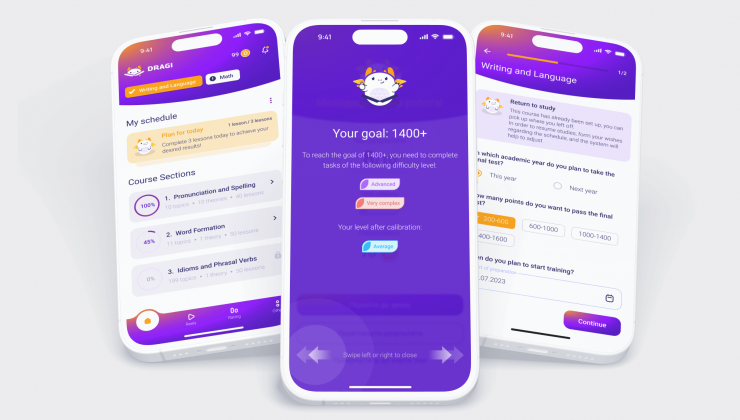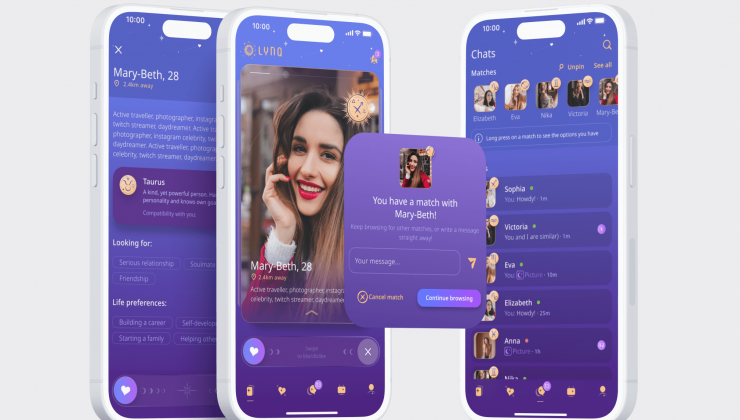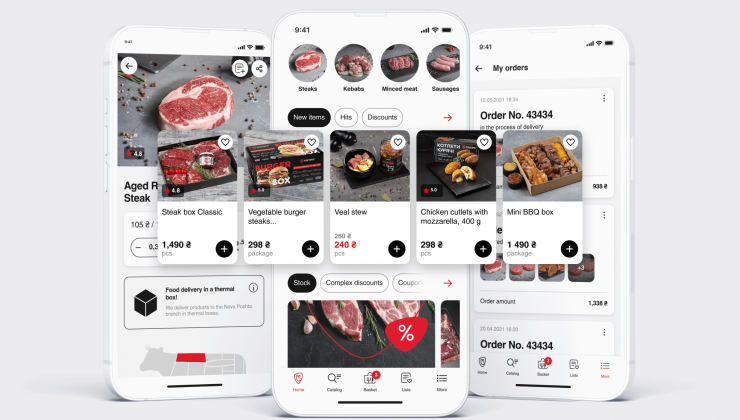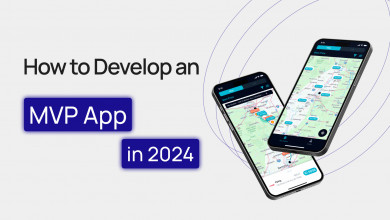Kicking off a new app development journey, everybody has but two pressing questions: How long will it take? And how much will it cost? The clearer the project scope, the more reliable outcomes you get. It is the timeline, however, that decides the project’s overall results and expenses in a major way, making it a first priority among all the preliminaries that you usually need to consider.
This article explores real-life examples and breaks down the stages of app development so you can understand what impacts the timeline and how to speed it up.
How Long Does it Take to Make an App by Complexity?
There are a myriad of factors, points, and circumstances affecting a project’s longevity. They may combine variously, based on the specifics of every other project workflow. To avoid vague, generalized descriptions of hypothetical situations, let’s try to analyze average project timelines based on our real-life case studies.
These should give you an accurate idea of the app development timelines you will most probably face during IRL app creation.
Simple apps like Dragi (6.5 months, 13 sprints)
Dragi is a mobile app for college students with a gamified, personalized learning experience. A great example of a basic application with the on-point, narrowed-down functionality. It took 6.5 months, with 13 sprints in all, to develop this cross-platform mobile solution for well-assisted exam preparation.

Dragi is a fully functional mobile tutor that reinvents exam preparation with gamified features and engaging content delivery. This type of app, though simple in scope, required thoughtful UX design and dynamic content management, leading to a 6.5-month development period.
Features implemented:
- Gamified learning: Students earn DRAGI tokens for completing tasks, with a competitive leaderboard system that motivates further learning.
- Reels format: Lessons and tasks are presented in a short video format, akin to TikTok but with an educational twist.
- Adaptive task difficulty: Algorithms adjust the task difficulty based on student performance.
Note that this is an above-average timeline for projects of similar scope, but this one came out really feature-rich. Particularly, the app features a uniquely designed user experience that incorporates interactive content, gamification elements, and adaptive learning algorithms.
Mid-level apps like Lynq (6.5 months, 13 sprints)
Lynq is a smart dating app that stands out from competitors by combining familiar mechanics (matches and swipes) with unique gamification features centered around astrology. The client came with a pretty clear vision in mind — we had to do cross-platform functionality for iOS and Android, a web admin panel to manage user data and app features, and a marketing landing page for project promotion, among other things.

Features implemented:
- Dating calendar: Offers astrological predictions for the best dating days via a personalized calendar.
- Crystal ball: Provides small predictions and zodiac compatibility insights for Pro users.
- Zodiac filtering: Allows users to filter potential matches by zodiac signs.
With its mid-level complexity, Lynq’s unique zodiac-themed design, gamified features, and cross-platform requirements led to a 6.5-month development timeframe — a fair average for this type of task. It is an only slightly more complex and voluminous project, but the additional backend requirements for user management and admin functions also contributed to this timeline.
Complex apps like Miastoriia (8 months, 16 sprints)
Miastoriia is a highly complex app combining e-commerce and online restaurant functionality. With this one, we had to introduce numerous new and integrated elements, with plans for extra features after the release. For instance, we needed to implement the GraphQL backend to grant scalability for future digital ecosystem expansion, making this a truly complex project with an extended timeline.

Features implemented:
- Mobile app integration with an existing store chain.
- Backend development with space for future scalability.
- Integration with iiko service for production control and accounting.
Miastoriia app’s development took 8 months, involving 16 sprints in all, advanced tech stack, and challenging project stages and decisions, mostly due to the app complexity-timeframe ratio.
Key Stages of the App Development Process
To get even more in-depth on the topic, let’s also take a look at the average time requirements for each stage underlying the project impact. Here are the key stages that can influence development time.

Stage #1. Discovery (4-6 weeks)
First things first, we need to go through the app concepts and ideas, come up with the technology stack, and outline a workflow plan for the whole project. All of these preliminaries and more (like market and competitive research, concept studies, etc.) are never to be neglected. This is why they take a felt stretch of time.
The discovery stage generally takes around 4-6 weeks, depending on the app's complexity. For example, the initial discovery for our use cases looked as follows:
- Dragi took 4 sprints to research, analyze, & kick off
- Miastoriia took 3 sprints
- Lynq 5 sprints
Stage #2. Design sprints (4-6 weeks)
The design phase is where UI/UX specialists work on a traffic-inviting, engaging, and accessible interface for the app. This process usually centers around wireframing, sketching out and creating UI/UX designs, and conducting QA and user testing to guarantee the app’s total usability.
The main tip here is that you must avoid mid-project design changes as much as possible, setting a sturdy, reliable foundation right away. For this, you can iterate the designs. In the case of Lynq, for instance, the design included branding, and we worked on unique elements from the get-go, which helped avoid redesign delays.
Stage #3. Development (3-8 months)
Even though commonly more technical, the development phase can vary a lot in its timeframe. The coding and integration of app features can be very effort-intensive, even if the tech scope is narrow. Alternatively, apps that are feature-rich yet centered around quite common functionality (like a template-based business portal) may be done faster due to a lack of tech skill challenge.
- For simpler, more basic apps, full-cycle development may take as little as three months.
- As you see from Lynq’s case, it went just over six months, with its cross-platform requirements setting the stage for a just-above-average project complexity.
- Big and advanced apps like Miastoriia, which required custom backend integration, take two-three months longer, up to eight months in total.
Stage #4. Deployment (2-4 weeks)
The final stage is deployment, where you need to polish out and prepare the app for public launch. This may require setting up a server, figuring out app store submissions, and conducting quality assurance checks to achieve the smoothest performance possible. A lot here depends on the final platform of public use for your new app.
For example, Apple Store is known for its more scrupulous and demanding app submission process, while Google’s Play Market is inherently simpler to take on (albeit with its own nuances). Naturally, apps like Miastoriia, with backend dependencies, may take longer to deploy, while simpler apps can be launched more quickly.

What Slows Down the App Development Process?
With all the above said and done, the best way to fend off downtime, speed up project processes, and maximize project efficiency is to keep knowing what to expect and how to take on common challenges. In particular, the main sources of bumps for your app development process include the following.

Mid-project changes
One of the biggest common pains in the app development process is a change that appears in the project scope mid-way through its completion. This could be about adding new features, customizing existing capacities, or even shifting the app's whole core platform and user-centric purposes (like switching from B2C to B2B and vice versa).
Any changes made after development has started oblige specialists to revisit the early stages of planning, design, and development. This may call for a complete overhaul of certain app features, which could push the timeline back by weeks or even months.
Example: A successful app may originally plan to launch as a basic cross-platform app, but if the client decides to add augmented reality (AR) functionality midway through, developers will need extra time to incorporate and test new features.
Inexperienced developers
The skills and expertise of the app development team are paramount for keeping the project on track. Teams with limited experience may come across difficult challenges in handling advanced technologies, complex integrations, or app scalability.
An inexperienced development team might struggle with implementing sophisticated features, generating bugs, inefficiencies, and rework. This not only increases the time it takes to develop the app but also affects the overall app quality.
Example: A team that hasn’t worked with certain app complexity before might face hurdles when developing real-time data processing for a financial app, delaying the app launch due to extensive debugging and testing.
Complex technologies
Choosing complex or new technologies, such as artificial intelligence (AI), blockchain, or advanced data encryption, can also stretch development timelines. While these technologies can add significant value to the final product, they need to be learned and mastered first.
Implementing cutting-edge tech requires extra time for research, testing, and debugging. Developing apps with intricate algorithms or AI models is not just about building features but also training models, fine-tuning performance, and running comprehensive tests to ensure reliability.
Example: Integrating machine learning into a high-quality app for personalized recommendations or fraud detection may require months of data training and testing, delaying the app creation.
Industry-wise difference
Certain industries, such as finance, healthcare, and insurance, are highly regulated. This means that apps built for these sectors need to comply with strict standards regarding security, privacy, and data handling.
Sticking to all regulatory frameworks can slow down development as the app development team finds ways to meet all legal requirements before deployment. This also may imply extensive documentation, third-party audits, or additional testing for security compliance.
Example: An app for the healthcare sector will need to be HIPAA-compliant in the U.S. or follow GDPR regulations in Europe, requiring developers to implement advanced encryption, patient data protection, and other privacy safeguards.
How to Speed Up the Time of Application Development?
Speeding up the app development process is about maximizing the efficiency of project workflows without sacrificing the final product quality. It is also the ultimate way to adjust regular project kick-offs and save tons of hidden and other extra expenses. But you need to know how exactly you can impact the rapidity of the job.
Here are some actionable ways to expedite the timeline while still building a high-quality app:
MVPs and prototyping
Building a Minimum Viable Product (MVP) helps streamline the process by focusing on core features first. For instance, Lynq could have launched its dating calendar feature as part of an MVP while building out extra astrology-based features for future updates.
- Why it works: By narrowing down the feature set to the essentials, you cut down on development time and resources. Launching an MVP allows you to gather feedback from real users quickly and iterate the app over time based on actual user needs and not vague assumptions.
- Tip: Instead of building a fully-fledged cross-platform app for both iOS and Android at once, start with a basic version on one platform. Once you validate the app idea with users, you can expand and optimize the app for other platforms.
Going cross-platform
Using cross-platform development frameworks like React Native, Xamarin, or Flutter can save time by allowing developers to write code once and deploy it across multiple platforms. Lynq is a perfect example of a cross-platform app, developed for both iOS and Android in a single development cycle.
- Why it works: Cross-platform development eliminates the need to write separate codebases for each platform, significantly cutting down the time and cost needed for creating an app for multiple platforms.
- Tip: Companies building apps like UberEats or Airbnb rely on cross-platform solutions to make sure their app reaches users on both iOS and Android simultaneously, saving weeks or even months of development time.
Hiring a professional developer
Working with experienced developers is a must. Only seasoned specialists can foresee potential issues, avoid bottlenecks, and speed up development by using proven methodologies. At WEZOM, we have extensive experience across a range of app types and ensure optimal team composition for every project.
- Why it works: Experienced developers have honed their skills through years of practice, meaning they can expect potential issues, use the best-suited technologies, and apply their knowledge to avoid common pitfalls.
- Tip: If you hire a skilled team with experience in native app development or complex enterprise solutions, they are more likely to deliver the app on time, while maintaining top-tier quality.
Agile development
The Agile methodology breaks the development process into smaller, manageable sprints, where a certain subset of features is completed each time. This allows for quicker iterations and enables teams to adapt to feedback without causing delays. Agile methodologies, particularly Scrum, are excellent for speeding up app development.
When we were developing Miastoriia, using agile sprints allowed for incorporating new features, like advanced swipes, without extending the overall timeline.
- Why it works: Agile allows for continuous feedback and incremental updates, enabling developers to stay focused, avoid rework, and smoothly adapt to changes without overhauling entire chunks of the project.
- Tip: In the app development project for Miastoriia, 16 sprints were planned and executed efficiently using Agile principles, which ensured all features were implemented within a structured timeline without delays.
Automated testing
Automated testing helps to identify bugs early in the development process, cutting the time spent on manual testing and rework. It helps make sure the app remains stable and functional throughout the development phases.
Automated testing tools like Selenium, Appium, or TestComplete can help you speed up the testing phase by running tests on multiple devices and platforms simultaneously.
- Why It works: Automated testing helps catch bugs earlier in the development process, minimizing post-launch bug fixing. It also allows developers to test various scenarios at scale.
- Example: If you are building an app for iOS and Android, automated testing can help emulate and approve the app's functionality across a variety of devices, operating systems, and environments, achieving a smoother app launch.

Bottom Line
The average time to develop an app depends on is very dependable. But it can be influenced and even manipulated if you know what you’re doing. Whether you are building a simple app like Dragi, a mid-level app like Lynq, or a complex app like Miastoriia, understanding the underlying stages and strategies can give you more than a hint on how to minimize expenses and maximize workflow efficiency.
The only other thing you need is firm expertise and skill. If you need to launch a profitable mobile app development project with well-analyzed milestones and guaranteed results, turn to qualified specialists at WEZOM — we offer an extensive portfolio and years of profiled expertise that can be dedicated to your specific needs.



